Brendan I. Koerner's Blog, page 31
November 30, 2011
Half Past Never
Stealing a day to write before picking up Microkhan Jr. from preschool. Back tomorrow with something on the evolution of bomb-squad armor.
November 29, 2011
Groggy
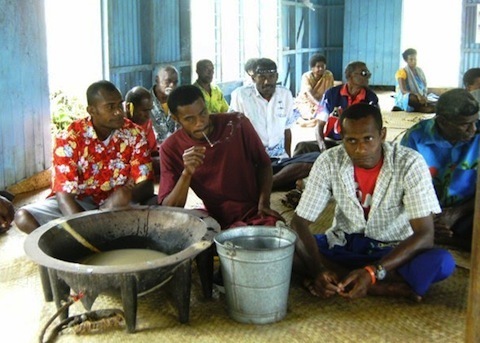
It's no secret that myriad small Pacific nations are having problems with First World diseases, especially those related to obesity. Fiji's dictatorial government believes that its citizens' expanding waistlines are due not only to food consumption, but also to overindulgence in yaqona, a mild intoxicant you may know better as kava:
Fiji's all-time favourite pastime, yaqona drinking, is under scrutiny because of its contribution to unhealthy living and non-communicable diseases.
Health experts say yaqona sessions in the afternoons should be replaced by physical activities like gardening and exercise.
What some may say is a good way to unwind after a hard day's work is being described by health officials as a contributing factor to NCDs like diabetes and hypertension.
"We can do without these grog sessions, especially men. They can instead do daily physical activities like gardening and exercise," says West medical officer Dr Torika Tamani.
By targeting the drinking habits of its urban dwellers, Fiji's government is opening up a new front in the war on yaqona. Earlier this year, it launched a crackdown against the homebrewing of yaqona in rural areas. But people in towns typically buy from vendors rather than making their own. And they do so not only because they like the gentle buzz of yaqona, but because agricultural realities have made the stuff so darn cheap. Explanation of the economics at work in the yaqona boom here:
Increasingly, yaqona is becoming an important cash crop, grown extensively for commercial sale. In some parts of the country it has become the leading cash crop. In the upper Wainimala, certain villages depend on it for up to 85 per cent of their cash incomes and Sofer has noted its increasing significance in peripheral regions such as Kadavu and Lomaiviti. In Kadavu, Sofer showed that yaqona was replacing copra as the leading cash crop, mainly because it brings higher and more stable returns to producers. Because of the distance and high cost of transport between the outer islands and the main urban markets in Fiji, and because it is relatively non-perishable, yaqona is proving a particularly suitable cash crop for peripheral areas. Other market crops, more perishable, do not reach the urban centres in saleable condition.
The only long-term solution to Fiji's self-destructive love affair with yaqona, then, is to improve transportation between rural and urban areas, so that farmers can profit by raising more perishable crops. But such development requires both dedication and patience, neither of which the current regime seems to have. And so they will instead attempt to convince young men to forego their daily drinking sessions in favor of gardening. Good luck with that.
November 23, 2011
Reeling in the Days
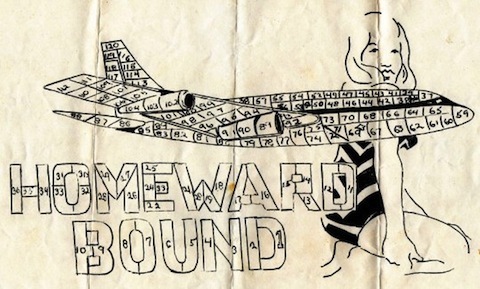
One of my very first posts, way back in the unenlightened days of April 2009, was about the art objects crafted by World War I's unfortunate grunts. Since then, I've always kept an eye peeled for the artwork of combat soldiers, which is often formed in the most desperate and uncomfortable of circumstances. I love this idea of creative energy acting as a bulwark against, for lack of a better word, insanity.
A great example, which I cite in the upcoming book, is the genre of short timers's calendars from Vietnam. When someone had just a few monts to go on their tour, they often made a hand-drawn calendar on which they could mark off their remaining days "in country," one by one. Many were lewd and crude, or at least on the risque side of things. (A large-scale NSFW favorite here.) Others were just wholesomely cartoonish, or dare I say informative. All exuded a certain gallows humor that only men who've witnessed terrible carnage can understand in full.
Happy Thanksgiving, dear readers. See you back here on Monday, hopefully with another 4,000 words of book copy beneath my belt.
(Image via Letters to Larry)
November 22, 2011
Alien in Alabama

The deeper I get into my latest book project—just crossed the 30,000-word mark—the more I keep digging into memories of my formative reading experiences. Doing so goes a long way toward helping me understand why I'm attracted to certain stories, and that self-awareness helps me separate the narrative wheat from the narrative chaff.
Loyal followers of this project already know what a big role Sports Illustrated played in making me want to write. I've recently highlighted a few stories that have always stuck with me, like Tommy Chaikin's steroid nightmare and Billy Shaw's self-destructive prison escape attempt. Another long-forgotten gem popped to mind the other day, while chasing after a book-related research tangent about East Germany: the tale of swimmer Jens-Peter Berndt, who decided to defect to the United States while switching planes at the Oklahoma City airport. The passage that got its hooks to me was this one—the fish-out-of-water detail really hit home for a grade-schooler who loved nothing more than hitting the Jack in the Box drive-thru with his folks:
By nature gregarious and self-confident, Berndt was ebullient as he toured the University of Alabama campus, met students, asked questions ("Which newspapers are controlled by which political parties?"), and took in a basketball game and a swim meet. While placing an order on his first visit to a drive-through fast-food restaurant, he exclaimed, "I'm talking to a sign!"
I'm talking to a sign. I still remember reading those words and realizing, for the first time ever, that I'd taken for granted the obviously ludicrous act of speaking to a slab of plastic festooned with clowns. And in some ways, I envied Berndt his innocence, the fact that he would spend the best years of his life experiencing the small pleasures of the West with virgin eyes.
I'm currently operating on the theory that there are essentially two kinds of non-fiction narratives: those in which the characters are the ones thrust into strange circumstances, and those in which the reader is the primary alien. Because of my early encounters with stories likes Berndt's, I obviously gravitate toward the former kind of yarn. I like characters who get lost, particularly by accident rather than design.
This is Jens-Peter Brendt today, by the way. He seems to have adjusted to American life quite well. I like to imagine he's still wowed every time he uses a drive-thru. But I know in my heart that's not the case.
November 21, 2011
The Flipside of Nonsense
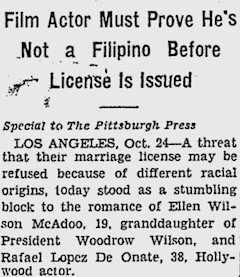 There is an interracial romance at the heart of my next book, so I've spent appreciable time researching the question of how such couples were regarded in the early 1970s. As is typically the case, that line of inquiry has piqued my interest in a tangential matter: the creation of anti-miscegenation laws specifically targeted at Filipinos. Much to my surprise, some of the nation's more traditionally open-minded states enacted such laws in the early part of the 20th century. California is one prime example; after a 1930 court case found that the states anti-miscegenation laws did not specifically bar couplings of Filipinos and whites, the legislature acted with extreme alacrity to correct that "oversight." The result was stories like the one cited in the newspaper clipping above, in which Filipinos were compelled to prove that they lacked "Malay blood" before obtaining marriage certificates.
There is an interracial romance at the heart of my next book, so I've spent appreciable time researching the question of how such couples were regarded in the early 1970s. As is typically the case, that line of inquiry has piqued my interest in a tangential matter: the creation of anti-miscegenation laws specifically targeted at Filipinos. Much to my surprise, some of the nation's more traditionally open-minded states enacted such laws in the early part of the 20th century. California is one prime example; after a 1930 court case found that the states anti-miscegenation laws did not specifically bar couplings of Filipinos and whites, the legislature acted with extreme alacrity to correct that "oversight." The result was stories like the one cited in the newspaper clipping above, in which Filipinos were compelled to prove that they lacked "Malay blood" before obtaining marriage certificates.
One state that resisted the trend was Washington, where Filipino anti-miscegenation laws were defeated in both 1935 and 1937. In the latter instance, opponents rallied around an op-ed that focused primarily on the fallacious science of the fearful:
In March of 1937, the Philippine Advocate published an article by Catelino Viado, a Filipino author, claiming that there was "no race deterioration in mixed marriages." Here, the argument was based not only on American ideals but on the fallacy of racist pseudoscience in claiming that intermarriage would produce "race deterioration." In making his point, Viado used the example of plant and animal hybridization to produce superior natural products, arguing that the notion of "race deterioration" from mixed marriages was a product of "petty jealousy and race sentimentalism" and could potentially improve the human race.
I like how Viado turned the common pseudoscientific argument on its head, in a manner that probably never occurred to people who benefitted from hybridization in their daily lives. Makes me wonder how much more harmonious a world we could live in if scientific literacy were ratcheted up a mere notch or two. There is a certain amount of wisdom and perspective that comes from understanding our relative lack of uniqueness in the grand scheme of life.
November 18, 2011
The Pivot
Dedicating the next three days to finishing another chapter of the book. This one's key, because the meat of the narrative starts in the ensuing chapter. And as much as I enjoy weaving together random tidbits of historical background into a semi-cohesive whole, the real pleasure in this process will come from recounting the tick-tock of a fantastic crime. Wish me luck and fortitude as I polish up these 6,000 or so words, and see you back here on Monday.
November 17, 2011
Ain't Goin' Out Like That
It's been far too long since I posted about suicide, a Microkhan staple since this project's earliest days. Let me rectify that oversight by quoting from this 1971 study of mortality among Hiroshima survivors. One might expect such unfortunate souls to be so psychologically traumatized by their experiences that they would be unusually prone to taking their own lives—as is traditionally the case with combat veterans. But the evidence tells a very different story:
In addition to the analysis of all 853 deaths as a single class, separate analyses were performed for the 162 accidental deaths in motor vehicle accidents, the 363 deaths from other accidents, and the 299 deaths from suicide. The first two supplementary analyses contained no suggestion of a relation between mortality and distance or dose, but the third revealed variation that merits further study, namely, a real deficit of suicides among those who received 10-39 rads, and among those in the highest dose (and more proximal distance) groups. The deficit among those exposed to 10-39 rads derives almost entirely from Hiroshima males(5 observed vs. 19 expected). There were no suicides in the group exposed to 180+ rads until the one observed in 1962-1966, and both sexes in both cities contribute to the discrepancy. This is not just a reflection of the retrospective assignment of dose estimates, for the distance analysis gives a comparable picture: among distance group A subjects, there were 21 suicides observed vs. 28 expected, over the 16-year interval. In the parallel analyses of those who were not in the city ATB vs. the A-bomb survivors, the risk of suicide, relative to that for subjects not in the city ATB, is 0.93 among Nagasaki survivors, but 1.43 among Hiroshima survivors (P < 0.05). Whatever the causes, therefore, the nature of the discrepancy is such that the highest relative risk is seen among the A-bomb survivors exposed to the least radiation.
In other words, the more traumatic one's radiation-related injuries, the less likely one was to commit suicide. This doesn't square at all with my expectations, especially given that many of those high-dose victims must have lived with constant physical pain. So what was it about the survival experience that turned them off the idea of taking their own lives when things looked grim?
I can only harken back to my August 2009 post about Jaswant Basuta, the man who was five minutes too late to board Pan Am Flight 103. There is obviously something deeply transformative about a brush with death, and I can only imagine that the effect increases in direct proportion to the spectacularity of the near miss—and, perhaps, its unexpectedness. Soldiers live each day with the specter of death, so surviving a battle is almost routine. But civilians are more blindsided to be reminded of life's exceedingly fragile nature. And when the event that brings them to the precipice is something truly historic, they must surely come away feeling that they have received a very precious gift.
Or maybe I'm just totally off, and there is a cultural explanation for the reluctance of Hiroshima survivors to commit suicide. Would love to hear alternate theories from more learned Nipponophiles.
November 16, 2011
Managing the Bloodshed
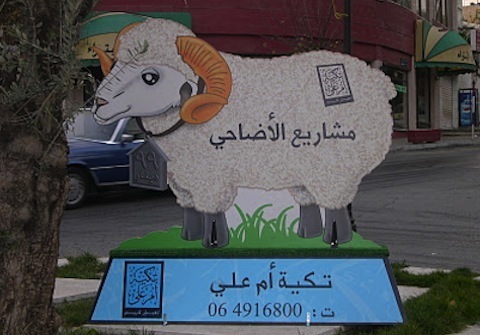
While heading to Microkhan Jr.'s preschool the other day, I heard a dreadful squawk emanate from courtyard of an apartment building. It took me a moment to realize that someone was killing a chicken for supper—a bird likely purchased from one of Queens' many live poultry shops. I had no problem with the violence, as I'm under no delusions about where my beloved pollo a la brasa comes from. But the chicken's death rattle did get me thinking about how city-dwelling Americans are so isolated from the spectacle of animal slaughter—a relatively new phenomenon in human history.
That is not the case in Muslim countries, though, for animal sacrifice remains integral to the festival of Eid al-Adha. Yet several such nations are now dealing with a situation that is the opposite of that which exists in the U.S.: animal killings are so numerous in densely populated urban areas that health problems loom. Take the case of Pakistan, where government officials are finding it harder and harder to clean up after each year's festival. In cities with populations that run into the millions, that neglect can have serious consequences:
Residents of Iqbal Town in Dhoke Mangtal in Rawalpindi told The Express Tribune that animal fat is being used by local factories for soap, oil and kitchen utensil manufacturing. The stench from these factories makes the air unbreathable for the local populace and the remains themselves pose a health hazard.
The basic health unit in Iqbal Town, for instance, is right next to a storage point where animal remains are being stored. "It is impossible for doctors to do their routine work with this smell," said a female attendant.
Residents of the twin cities were instructed by civic bodies not to dispose of animals remains in garbage trolleys, drains or green areas and to instead place them outside their houses to be collected by the agencies' sanitation staff. However, before the sanitation staff could complete their rounds, 'vigilant' labourers from local factories collected a substantial number of animal remains, sources added.
Muhammad Sarwar, a resident of Dhoke Mangtal, said that factory workers collected the bones of sacrificial animals at the Railway Ground during Eid days. "Now they burn these bones during the night to manufacture utensils and the smell that it gives off is unbearable. We can't sleep at night," he added. Another local, Pervez, said the city administration was ignoring their plight.
Pakistan's airports must also cope with flocks of scavenger birds, which have come to feast on the carcasses of slain sheep that were dumped next to runways.
Ultimately, letting individuals sacrifice animals in cities is probably too deleterious to public health to allow. Saudi Arabia seems to have the right solution to this problem with its sacrifice-by-proxy system, in which urbanites purchase coupons that grant government-run slaughterhouses the right to sacrifice sheep on their behalf. True, clicking that "Add to Shopping Cart" button may not provide the emotional thrill of participating in an Eid sacrifice first-hand. But our species does need to adjust to the fact that we're often happiest when living in clumps.
(Image via Adventures with Yo and Mo)
November 14, 2011
Progress Report
Lost the morning to a parent-teacher conference at Microkhan Jr.'s school. Now on to shaping my next Wired feature. Back to this space as soon as humanly possible.
November 11, 2011
Local Knowledge
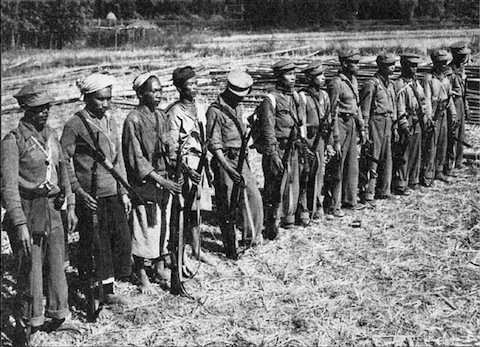 A brief Veterans Day special today, as I try and dedicate a strong eight hours to the book. I was planning on directing your attention to this excellent site, which honors the men and women of the 335th Station Hospital in Tagap Ga—the Burmese hamlet where so much Now the Hell Will Start action goes down. But I just couldn't resist the temptation to give some love to the Kachin Rangers, the unit of Burmese jungle fighters our men in OSS Detachment 101 pulled together to help clear the way for the Ledo Road. Nice details here of what the Rangers provided, aside from their traditional skill with square-bladed daggers:
A brief Veterans Day special today, as I try and dedicate a strong eight hours to the book. I was planning on directing your attention to this excellent site, which honors the men and women of the 335th Station Hospital in Tagap Ga—the Burmese hamlet where so much Now the Hell Will Start action goes down. But I just couldn't resist the temptation to give some love to the Kachin Rangers, the unit of Burmese jungle fighters our men in OSS Detachment 101 pulled together to help clear the way for the Ledo Road. Nice details here of what the Rangers provided, aside from their traditional skill with square-bladed daggers:
The Kachins taught the Americans how to use punji sticks; the sharpened bamboo stakes that were made needle-sharp and then tempered in fire. These stakes were "poisoned" with rotten pig's liver or with human dung. They would place these stakes well hidden on both sides of the trail. When the enemy patrol came down a trail and was fired upon, the Japanese would dive for the bushes beside the trail. Many of them were killed in this manner.
More on the Rangers, in the purple prose of the early 1940s, available here. And remind me some time to dig up the documents I have regarding the Kachins' very rigid rules regarding interactions between their women and American soldiers. Leers were not appreciated, to say the least.




